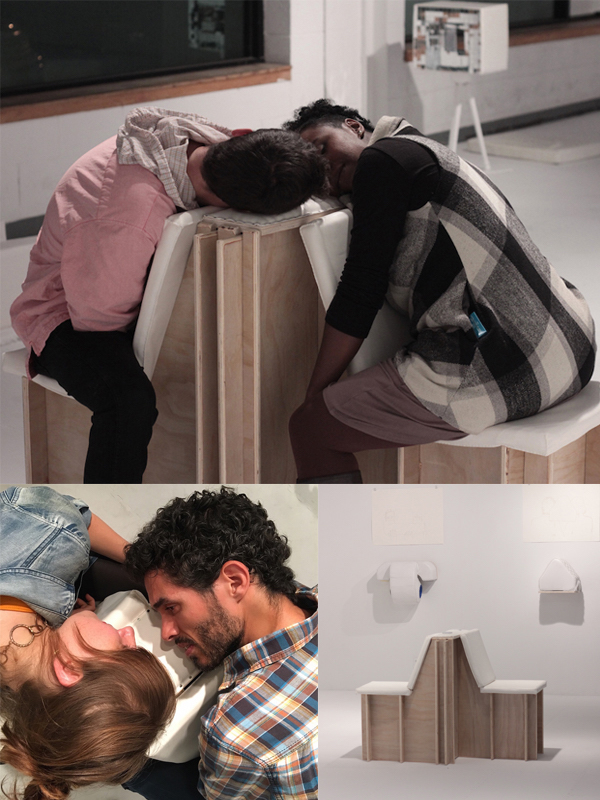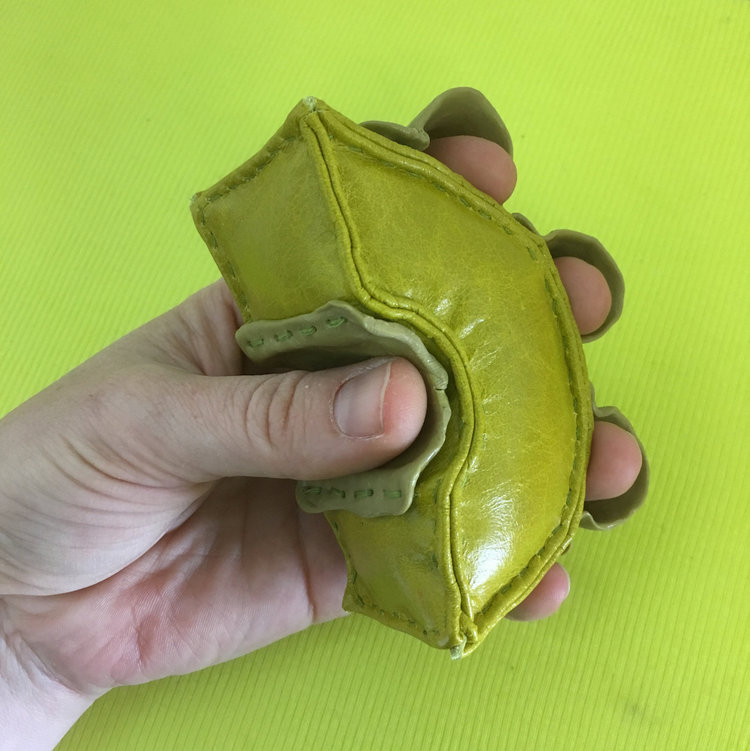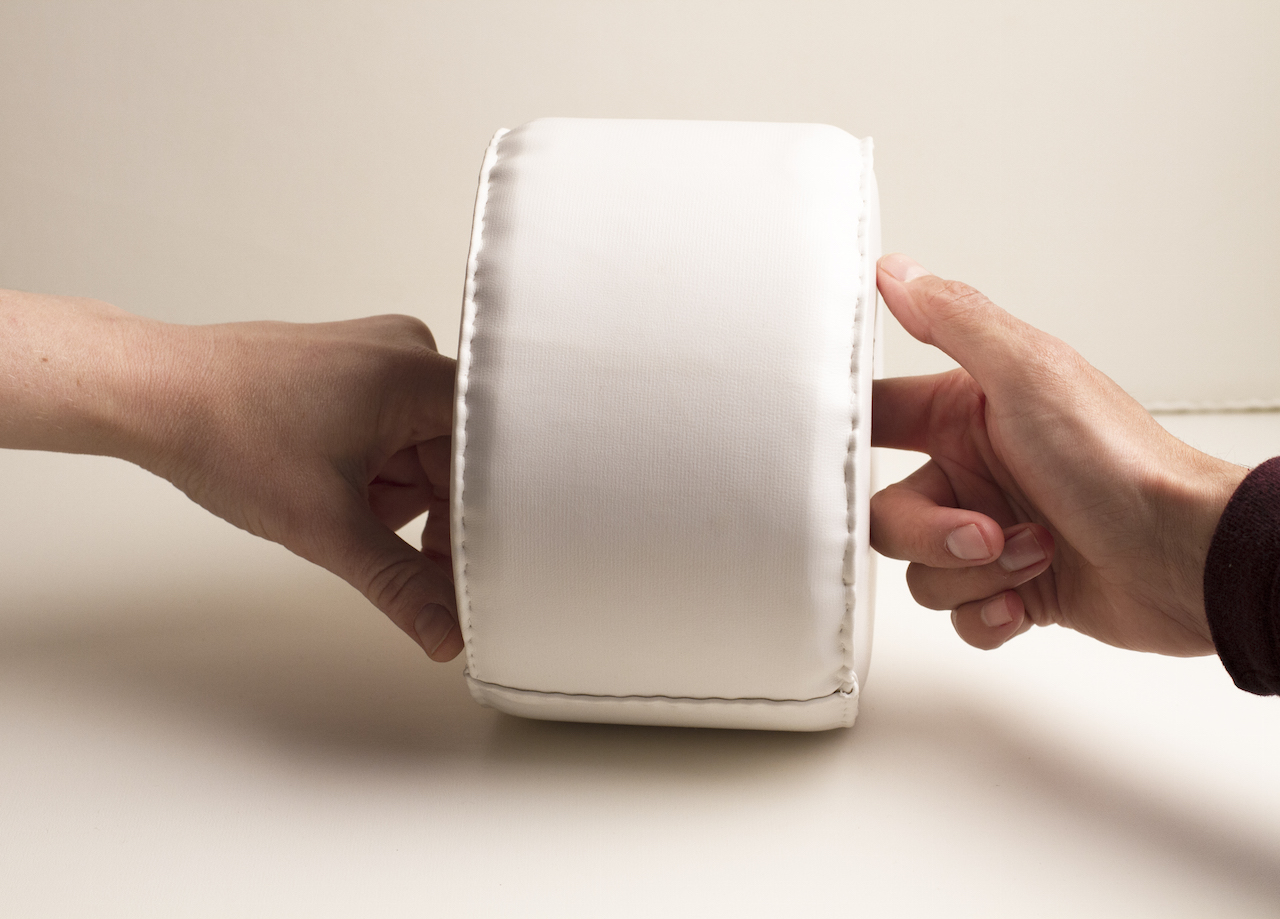I touch you and you touch me: Ergonomic intimacy and bounded bodies in Liz Nurenberg’s participatory sculptures.
by Tucker Neel
Peripheral Vision Journal, No. 8
Whether it’s a handshake, kiss, fist, chest, head, or fist bump, or any number of deferential gestures, every culture - both popular and sub - shares stated and unstated beliefs about how one should go about meeting and touching - or not touching - a stranger. But what are the bodily protocols after this initial contact? Is it possible to speed up the process of socialization through prescribed alterations in physical interaction? If I put my head here and you put your arm there, will we be friends faster? These questions, and a larger inquiry into how to better get people together both physically and mentally, motivate Liz Nurenberg’s practice. Her body-bound sculptures aim to assist in the production of social intimacy and ask us to pay attention to the shape of human contact so we can better activate the potential in the otherwise empty spaces between us.
It’s imperative to Nurenberg that people don’t just passively view her work. You have to touch her work to “get it.” Sometimes you're supposed to do this alone; but more often you’re prompted to do so with another person, preferably a stranger. Visitors were afforded this opportunity with her 2016 exhibition Body, Object, Body, Mark, which presented a selection of amorphously shaped soft sculptures on pedestals and the floor, in a manner resembling a behavioral science laboratory or a high-end minimalist toy store/showroom. The artist crafted all of her works out of conspicuously bright white material so they would slowly accumulate the fingerprints, footprints, scratches, and scuffs left by visitors over the duration of the exhibition, making indexical evidence formally and conceptually significant. One poetic piece from this exhibition, a white, pentagonal object resembling the outline of a house, sits on a shelf below an instructional drawing of two figures using the sculptures to complete a specific pose. Willing participants must work together to support the spotlit sculpture in the space formed between their aligned shoulders and tilted heads. The resulting tableaux contorts the two into an iconic silhouette of human connection, paired minds deviating from upright bodies leaning towards cerebral contact.
Nurenberg’s practice shares a conceptual and sometimes performative affinity with Erwin Wurm, an artist she enthusiastically admires. Her work echoes Wurm's ongoing series of one-minute sculptures where he presents simple, playful, installations of banal objects accompanied by crudely drawn instructions explaining how visitors should interact with them for one minute. In his works, willing participants might turn an oversized sweatshirt into an absurd shell, with legs where arms should be, and vice versa. In other works, he instructs participants to put paint buckets or tennis shoes on their heads or shove stuffed animals into their pants. In isolating and highlighting these behaviors in a museum or gallery context, he defamiliarizes mundane human behavior and recontextualizes the consumable objects we might take for granted. Nurenberg similarly plays with the expectations we bring to art, sculpture, and human interaction. But whereas Wurm relies on a kind of consumer abjection to give critical meaning to his work - employing the stuff you can buy at a store down the street - Nurenberg creates things that look enough like sculpture to put us at ease, creating a more experimental interaction between visitor and art object. Hers are test cases that seek to go beyond absurdity towards more profound connectedness.
Frequently Nurenberg causes body parts to intermingle, double, or disappear into one another. This is evident in her Twiddle, Poke, Hold exhibition from 2017, which presents viewers with a colorful selection of small objects meant to be held. These works sometimes include suggestive holes, fingers, phallus-like protrusions, and disruptive polyp-y growths that interrupt smooth surfaces. A video tells potential participants how to use them, either alone or with another person in the gallery. Fingers enter voids in pinkish fleshy tubes, and palms caress black vinyl alongside synthetic human fingers. There’s a lot of hidden touching and points of stimulation going on. Similarly, Nurenberg's Headpieces, a body of work from 2010, connect participants’ craniums via large, lumpy balls and soft slumpy tunnels of fabric. These implied mergers of bodies create what the theorist Susan Stewart characterizes as grotesques, amplified accumulations and extensions of bodies that exemplify and produce excess in enjoyable, celebratory ways. In her book On Longing, Stewart discusses the grotesque body and it’s mirror, the ideal body. She claims that an examination of the grotesque allows one to see the falseness of the ideal. She locates this ideal in the image of the other because, in true Lacanian fashion, one’s own subject-bound body is forever and always unknowable, and at base a grotesque frustration:
“Grotesque realism is emblematic of the body’s knowledge of itself, a knowledge of pieces and parts, of disassociated limbs and an absent center. The realism of the ideal is emblematic of the body’s knowledge of the other, a knowledge of facades, of two dimensions. Only in the embrace is the other’s body known as one’s own, in parts.”1
Nurenberg’s work aims to facilitate this equalizing embrace through what I characterize as the ergonomics of intimacy. Like a wrist brace prevents carpal tunnel syndrome, or an exercise ball improves one’s posture, Nurenberg’s works act like assistive props designed to to bridge the gap between self and other through calculated bodily interaction.
It’s worth asking what existing apparatuses, products, or behaviors, already exist to ensure two bodies touch, in public and private, in ways designed to promote similar states of acceptance and social intimacy. The few objects that come to mind illuminate the generosity and success of Nurenberg’s practice through points of comparison.
There are, of course, novelty clothes made for two people to wear. Couples slankets or snuggies come to mind. But these things exist mostly as jokes, caricatured codependency. A perfect example of this is the Pantalaine company, a 2005 invention of McSweeny’s Quarterly Concern. Though it existed only as a prank and not an actual store, Pantaline claimed to be the “provisioners of America’s finest plural clothing.” Their inventory included the Sweat-Heart Sweet-Shirt (a hoodie for couples), and the “Pantalaine classic hug jacket,” (basically a straightjacket built for two)2. While Nurenberg’s work is routinely funny, her humor comes from permissive absurdity, not the kind of satirical irony that underpinned Pantalaine’s products. Nurenberg’s work compels a chuckle the way a staring contest does; it disarms us and injects levity into what might be awkward interaction.
Additionally, Nurenberg’s work might seem to have a direct affinity with the Get Along T-Shirt. First popularized via reddit in 2012, this parenting hack consists of placing a large t-shirt over arguing children, forcing them together to de-escalate emotions and induce productive engagement. Anyone who’s been around kids knows this is as futile as it is adorable - which may account for the shirt’s continual life as a long-running participatory meme. But this congenital costuming won’t help stop the forces that lead to conflict or prevent it from happening again. Instead, the Get Along T-Shirt reinforces unhealthy ideas about power, proximity, and silence. Real discord and power imbalances are rarely resolved through imposed physical contact. When compared with the Get Along T-Shirt, Nurenberg’s work appears much more generous, non-prescriptive and freeing. In her works participants always have the permission not to participate. Nuremberg doesn’t employ restraints as a prerequisite for intimate encounters. In her work, you have to choose to engage. In this way she admits the limits of her objects and leaves the creation of genuine connection up to her audience; the work is a prop, not a prison; in effect, it fixes the punitive problems of the Get Along T-Shirt.3
A discussion of Nurenberg’s work wouldn’t be complete without addressing its relation to existing objects facilitating sexual contact. Her work often alludes to body parts, orifices, nipples, pubic hair, and phalluses and all the supporting buttresses, bolsters, cradles, and pillow-like forms in Nurenberg’s work suggest one should acknowledge similar objects used in the most intimate of acts as a way to understand how both function. Perhaps one of the most ergonomically intimate devices is the sex sling, which replicates weightlessness - a womb-like state - and at the same time uses penetrative actions as regenerative forces, causing both parties to remain connected while also conserving energy that can, if desired, be redistributed towards other exciting activities. In essence, that’s what a genuinely ergonomic mechanism does for the body; it allows it to do what it wants to do in a more efficient, healthy, and ultimately enjoyable manner, which sounds a lot like the goal of Nurenberg’s work.
But while the comparison between sex prop and social prop is tempting, it doesn’t work in this analysis. Sex toys have many uses, but they typically bring bodies together to produce libidinal intimacy. Nuremburg’s sculptures have another goal in mind; they facilitate social intimacy. Though sex toys and relational sculpture are not necessarily mutually exclusive and the use of one can indeed lead to the use of the other, it’s next to impossible to imagine this process inverted without a uniquely serendipitous meeting of people in a gallery who previously came together in a very different environment. Instead, I believe Nurenberg’s work has a surprising similarity with a much older set of tools designed to prohibit sexual contact, objects used in “bundling,” a strange dating ritual which began sometime in 16th century England, extended all the way to the American colonies, and ended in the Victorian era.
Bundling was a odd thing indeed, straddling semi-public and semi-private spaces and inter-familial relationships. The practice went like this: After declaring their love for one another, a young couple would go to the girl's house to dine with her folks. When it came time, her parents would “bundle” the love birds in separate sacks, each tied at the neck and place them in the family bed. The parents would then separate the horizontal youths with a custom-fit wooden plank partitioning the mattress in two. The couple was then free to get to know each other until the sun came up the next morning, wherein the parents freed them from their nocturnal encasings.
Now obviously this practice, like most parental controls, routinely failed in the face of insatiable adolescent libidos; it’s tough to stop kids from getting it on. But bundling did serve an important, instructive function. The ritual signified a progressive change in concepts of love and marriage. As one of the first courting rituals with explicitly sexual implications, a form of dating that gets as close to sex as possible, the unusual practice allowed for young couples to exercise a semi-autonomous agency when it came to deciding who they would love. In this way bundling briefly moved the idea of coupling awkwardly towards amorous love and marginally away from rigidly arranged marriages. It was a semi-public performance with mom and dad involved, a kind of domesticated, welcome-to-the-family S&M bondage that, through its various parts, aimed to prevent physical intercourse while allowing for permissive, proximal intimacy. In effect, bundling let young lovers fast forward to the pillow talk that otherwise bookends genital intermingling. In this way, the bag and the barrier are useful props; hey prioritize interpersonal discourse over intertwined intercourse, something much more in line with much of Nurenberg’s work.
This connection is readily apparent in one piece from Body, Object, Body, Mark, consisting of a sculpture that has two people lean forward towards each other on misaligned supports, similar to how one sits on an upright massage chair. When each rests their head, they must choose to face towards or away from the other’s face. Bodies are kept separate, but each participant’s head is allowed to get close to the other and perhaps even kiss. The art symbolically "bundles" the participants (sans sleep sack), delineating a space for a kind of connection that conventionally presages and conceivably eclipses the short-lived pleasure of sexual contact. Nurenberg’s artworks, her props allow one to experience a unique type of social intimacy through how bodies sit in relation to one another. In Nurenberg’s work, we get the unique opportunity to experience the fact that when you get close enough to another person, you can’t help but acknowledge the kinetic physicality of their presence; it’s in their smell, their warmth, and the way they consume all of your vision. Nurenberg’s work might not guarantee this kind of intimacy, but it sure does help move it along.
1. Stewart, Susan. On Longing: Narratives of the Miniature, the Gigantic, the Souvenir, the Collection. Johns Hopkins University Press, 1984. Page 115
2. See Eggers, Dave. McSweeney's 17: Made to Look like It Came in Your Mailbox. McSweeney's Quarterly Concern, 2005.
3. For a detailed account of the internet history of this meme see: http://knowyourmeme.com/memes/get-along-shirt.




©2024 Tucker Neel. All rights reserved.